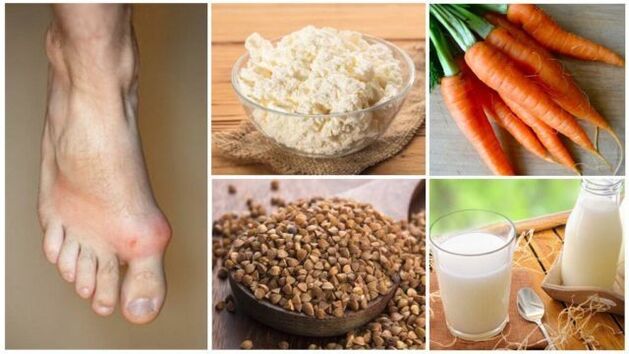
Improper nutrition, combined with decreased nutrient absorption, leads to gout progression. This disease develops when the level of uric acid in the blood exceeds the allowable limit (more than 420 μmol / l for men, 350 μmol / l for women). Disruption of metabolic processes leads to the fact that the salts of this acid break down on the intestinal walls, blood vessels, articular surfaces and damage important organs of human life.
Over time the disease becomes chronic with frequent relapses. In the acute period, patients experience severe pain at the site of localization of the pathological process. Diet for gout helps to normalize uric acid levels and reduce recurrences.
Why diet gout?
An important task of therapeutic measures is to reduce the nature and frequency of disease manifestations. This can be achieved by reducing the uric acid content in the body.
The development of gout attacks is caused by:
- Intake of large amounts of food in large quantities of purine substances;
- Metabolic disorder.
Diet optimization allows you to start the right processes of assimilation and excretion of substances. Therapeutic measures aimed at eliminating the causes of the development of the disease are closely related to the protection of the restriction of certain food addictions. With the help of a properly compiled diet menu you can slow down the progression of the disease.
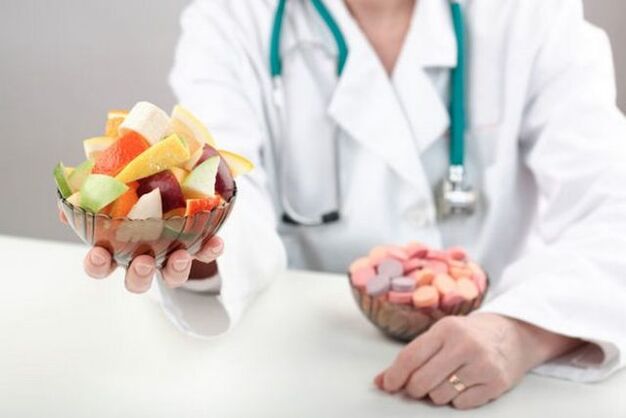
The food that makes up a person’s daily diet should include foods that have large amounts of nutrients beneficial to the body.
Gout nutrition therapy aims to reduce the symptomatic manifestations by eliminating the food components that provoke them. The products that a person consumes every day have a great impact on the state of health in general, are responsible for the chemical processes that take place in the human body throughout life.
What not to eat with gout?
Based on research, scientists have established a list of products that directly cause the initial development and subsequent progression of the disease.
The list of what not to eat for gout includes:
- Smoked spicy cheese and cheese product;
- Cholesterol-rich meat and bone products (pulp, hooves, bulldogs of young animals and pigs);
- Meat and bone fats, ear;
- Fish with high fat content (sardines, sprats);
- Pickled vegetables, pickled fruits (cabbage, watermelon, cucumber, apple);
- Hot, cold smoked products;
- Legumes (peas, beans, soybeans, lentils);
- Greens containing oxalic acid (spinach leaves, sorrel, basil root);
- Hot spices, sauces;
- Some types of vegetable crops (Brussels sprouts and cauliflower, radish);
- Internal organs of animals obtained during the slaughter of corpses (kidneys, liver, lungs, heart, brain);
- Oatmeal;
- Products using confectionery fat;
- Any percentage of alcohol;
- Fruits and berries (grapes, raspberries, figs);
- Hot, spicy and ethereal spices (bay leaves, chicken, chili-pepper);
- Animal fats and oil products (fat, margarine, lard);
- Canned meat, fish and vegetable products.
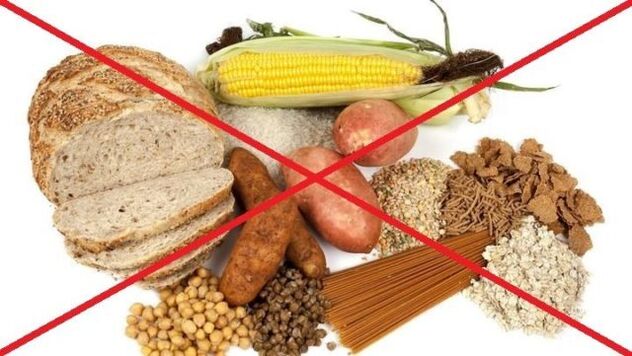
If the diet is not balanced or contains large amounts of fatty, spicy or heavy foods in the digestive system, then human metabolism may be disrupted.
List of products whose use is restricted:
- Coffee, strong tea;
- Butter;
- Plum;
- Night shade vegetables (eggplant, tomatoes, peppers);
- Table salt, granulated sugar;
- Fungus (only in remission).
To alleviate the attack, as well as to maintain a state of remission, it is important to remove the above foods from the diet for a long time.
What can you eat with gout?
List of recommended foods for use by patients with this disease:
- Dietary meat products (rabbit, poultry, lean beef);
- Lean white fish (pike, pike perch, tunnel, pollack);
- Bran and rye bread;
- Chicken eggs (except yolk);
- Cereal dishes (rice, wheat, buckwheat, millet, pearl barley);
- Fresh vegetables (beets, carrots, cucumbers, cabbage, potatoes);
- Seasonal fruits, berries (watermelon, melon, apricot, strawberry, peach, cherry, blackberry, green apple);
- Macaroni;
- Walnut kernels (nuts, walnuts, cedar);
- Herbal teas and decorations (dubrovnik, basil, kisses);
- Fermented milk products, cottage cheese;
- Freshly squeezed juices, fruit drinks, compotes;
- Boiled tomatoes;
- Spices (turmeric, fennel, basil);
- Vegetable oil (olive, rapeseed oil)

Gout nutrition therapy will help the patient to quickly get rid of unpleasant and painful symptoms at home.
In limited quantities, natural honey is beneficial for gout. This product is suitable as a sugar substitute.
Honey has many useful properties:
- Immunostimulation;
- Antioxidant;
- Improving metabolic processes;
- Bactericidal.
During the acute period you should not abuse this beekeeping product. Patients with this disease eat foods rich in vitamins, micronutrients, amino acids. A useful supplement is pharmaceutical fish oil for gout.
General rules of nutrition
Removing certain forbidden foods from your regular menu does not guarantee instant release. In addition, the list of products varies according to the stage and severity of the disease. Thus, goiter feeding during exacerbation involves more severe restrictions than during remission.
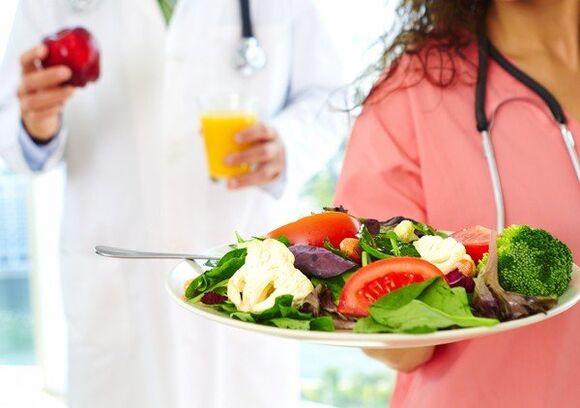
There is a common set of rules for patients with this disease that must be followed in diet therapy:
- Eat small portions of food several times a day at short intervals (5-6 times). Hunger causes an increase in acetone in the urine. And this can worsen the course of the disease.
- Chew food thoroughly, do not overeat.
- Limit the amount of table salt used in cooking (up to 5 grams per day). Salt has the property of retaining fluid in tissues, which in turn causes the precipitation of uric acid salts.
- Optimize body fluid balance. For this it is recommended to drink at least 2 liters a day.
- Arrange fasting days. Vegetables, milk and fruits are preferred (except for consumption prohibited).
- Adherence to restrictions for a long time because short-term use of therapeutic diet is ineffective.
People who have severe metabolic disorders, a history of diabetes and gout, should exclude foods that raise uric acid and insulin levels in the blood. Diet for gout and diabetes aims to reduce these rates to prevent exacerbations and complications.
How to prepare food properly?
Restrictions on grocery listings are not the only points to note. When preparing your dishes it is important to choose the right cooking method.
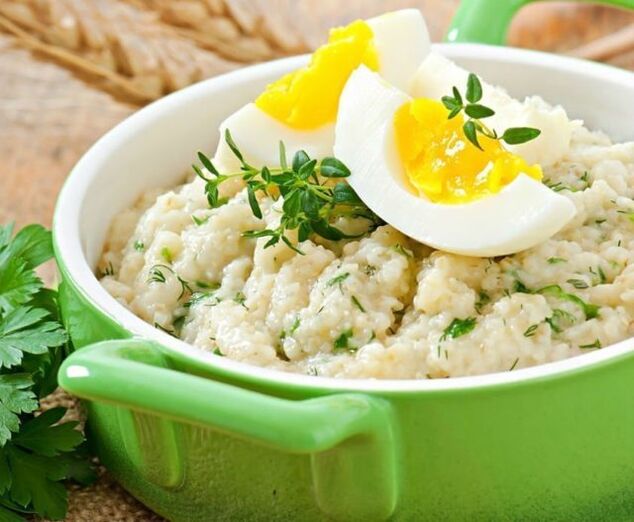
There are no special requirements for the preparation of products other than meat processing.
It is allowed to prepare in the following way:
- For a couple;
- Bread;
- Extinguish;
- Fermentation;
- Cursing.
Kitchen is contraindicated:
- fried;
- smoke;
- Salting and pickling;
- Fermentation.
Do not use stale, burnt food. The temperature regime of the consumed food should be optimal for the food and should not exceed 40 degrees Celsius. Food should not be rough and tough. If necessary, individual dishes can be cut with a blender.
Effective diet: menu every day
Medical nutrition containing important components (protein-carbohydrate-fat balance), calories, vitamins, micronutrients, amino acids should meet the physiological needs of patients.
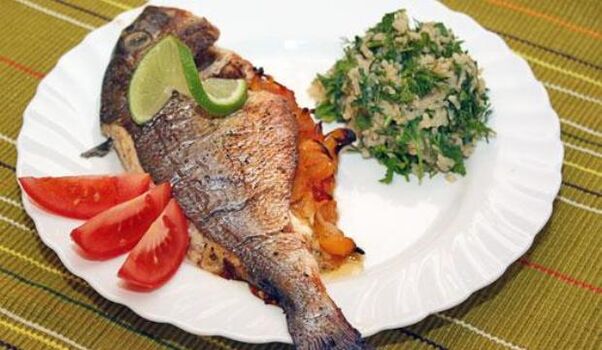
Estimated diet High in gout and uric acid:
1 day
First breakfast: boiled cod, mashed potatoes, black bread, white cabbage salad, sour cream seasoning, a cup of weak coffee with saccharin.
Second breakfast: curd casserole, boiled egg, bran bread, tea drink.
For lunch: vegetarian soup with fried roots and potatoes, beef, buckwheat porridge, fresh cucumber, 1 apple.
Dinner: carrot cutlet, pasta, milk, biscuits.
At night: 200 ml of kefir.
2nd day
First breakfast: stewed white cabbage, 1 boiled egg, black bread, cappuccino.
Second breakfast: cappuccino, biscuits.
For lunch: lean borscht, bran bread, poultry baked fillet, boiled rice, fruit jelly.
For dinner: stewed potatoes with vegetables, vegetable casserole, bran bread with butter, a glass of broth.
At night: 250 ml of cottage cheese milk.

Day 3
First breakfast: vegetable salad (white cabbage, carrots, apples), weak coffee.
Second breakfast: cottage cheese with sour cream, rose broth.
For lunch: barley soup with sour cream, steam cutlets, mashed potatoes, berry jelly, whole grain bread.
For dinner: carrot cutlet with fruit, semolina tasserole, a glass of milk.
Before bedtime: Steam prunes.
4th day
First breakfast: grated carrots with sour cream, wheat porridge, a cup of green tea.
Second breakfast: fruit cutlets, compote, biscuits.
For lunch: milk noodles, boiled chicken with baked pumpkin and potatoes, fruit jelly, black bread.
For dinner: baked cheese cakes in the oven, carrot and apple cutlets, a cup of tea with lemon.
At night: 200 ml of warm milk.
Day 5
First breakfast: porridge boiled in buckwheat milk, green tea.
Second Breakfast: One cup of fresh carrots.
For lunch: vegetable rice soup with sour cream, cooked beef pulp, beet caviar, basil infusion with honey, black bread.
For dinner: pumpkin pot with sour cream, a cup of weak tea, crackers.
Before bed: The rose is soaked in honey.
6 days
First breakfast: chicken protein omelette, stewed beets, white bread, a cup of weak coffee.
Second breakfast: zucchini casserole, fruit and berry compote.
Lunch: Vegetarian barley soup, boiled potatoes, stewed onions, jelly, black bread.
Dinner: rice boiled in milk, weak tea drink.
Before bed: one cup of yogurt.
The standard diet is compiled by your doctor. There are a variety of dietary permitted food combination options. Diet number 6 is common for gout. Its main principle is to exclude foods and dishes with a high purine component, to add alkaline beverages to the diet and to process them gently during preparation. An independently drawn menu, with restrictions on the amount and nature of food, can lead to prolonged illness.














































































